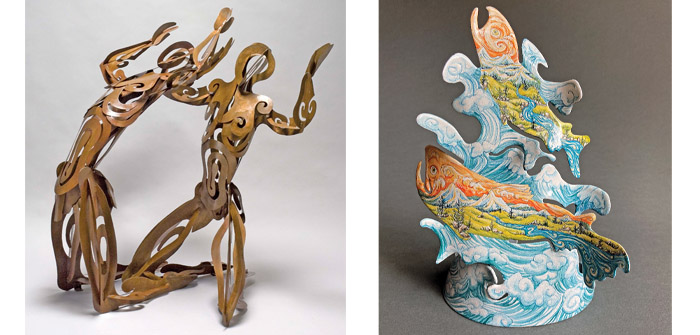((Left) Support with Joy (Right) Instincts Call Me Home | Sculptures by Alisa Looney)
Creating art as an instrument for change is the goal of many artists. In creating her art, Alisa Looney’s goal is to foster ecological and social healing. “I want to bring into light the interdependence of all living things,” she explains. “My intention is to capture moments of unseen connection between humans and nature, between wildlife and natural elements.” Her work is showcased this month at Red Chair Gallery.
Bringing attention to climate change is Looney’s “number one concern.” Her metal sculptures, which range from large outdoor installations to petite necklace pendants portray the interdependence of all living things. She says she tries to “tell stories of what it means to be human and how we connect with and care for this earth.” A wall mask will include a face with mountains as hair and crowned by a leafy tree; a human figure may reach to the sky for a tiny bird.
Another frequent theme in Looney’s work is the connected energy between people giving and receiving support from each other. She believes this is essential to create a meaningful life and a peaceful world. The bronze sculpture pictured here, titled Support with Joy, depicts this feeling between two figures.
Growing up on the Spokane River in Coeur d’Alene, Idaho, Looney was surrounded by the natural world of moving water, wildlife and forests, while she learned to draw and sculpt in clay and sand. In her teens she became a silversmith and then received a bachelor of fine arts from Boise State University. A long career as a professional graphic artist and illustrator funded her art endeavors, including learning to weld to build sculpture. In 2010 she studied enameling techniques and began to combine metal sculpture with narrative enamel work. After 29 years of living in Portland, Looney and her husband Wade Womack, also an artist, moved to Central Oregon in 2018 to be near the Deschutes River and surrounding forest.
The process for creating metal sculpture with enameling is extremely complex. First, Looney begins with a sheet of steel and cuts it, using plasma, laser or flame cutting techniques. Then she sands, hammers and welds it. Finally, she begins the time-consuming enameling procedure: She coats the piece with black ground coat enamel and kiln-fires it, fusing the glass to metal. Then she sprays it with white liquid enamel. After this dries, she draws in her designs with a fine-pointed tool and fires it again. Lastly, she applies colors and fires it a third time or more, for a lustrous glass finish.
The exhibit at Red Chair Gallery includes many creations by Looney, such as her Ode to Coral Reefs series which focuses on endangered ocean corals. Other current projects are sculptural wall reliefs, made of formed steel and coated in layers of colorful kiln-fired glass. One depicts the life of salmon and another shows a circle dance of humans inspiring protection of the planet. Looney is well known for her large public sculptures, which are installed at the Maryhill Museum of Art on the Washington side of the Columbia River, Cannon Beach, Oregon; Puyallup, Washington; McCall, Idaho; and several other places in the Northwest. Locally, she also shows her work at Hood Avenue Art in Sisters and the Artists’ Gallery in Sunriver.
Looney and her husband own River Art Adventures, where they offer art instruction to small groups in enameling and woodblock printing. Due to continuing concerns about COVID-19, Looney has limited her in-person instruction to two students per class and offers enameling courses online. You can find them on her website, alisalooney.com. She is also on Facebook and Instagram under Alisa Looney.

